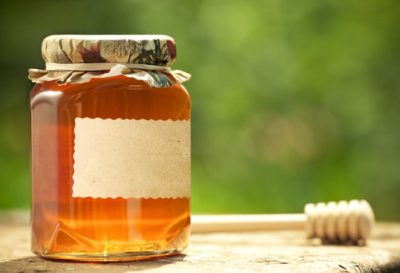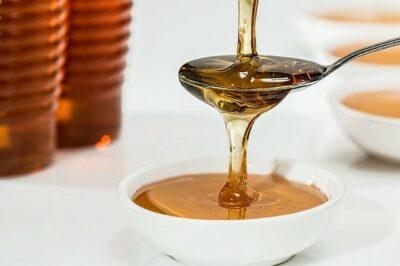September is National Honey Month, and the golden liquid seems to deserve the honor. Americans consume about 1.5 pounds of honey per person annually, and there are more than 300 unique types of honey in the U.S. alone.
Honey is made by honeybees from the nectar of flowers and plants; it is not made with pollen. Pollen is brought back by the bee as a source of food for its offspring or “brood,” and it can be introduced to honey through other means, such as during the extraction process. Trace amounts of pollen are, though, found in honey.
Raw Honey
You may be wondering about raw honey [2] versus processed honey. According to the National Honey Board, raw honey is honey that has not been heated or filtered. A 2012 National Honey Board study of the vitamins, minerals and antioxidant levels in raw and processed honey found that processing significantly reduces the pollen content of honey, but that processing does not affect honey’s nutrient content or antioxidant activity.
Some honey found on supermarket shelves has been pasteurized, which means it has been heated at extremely high temperatures and rapidly cooled so that it looks more appealing on the shelf. Unfortunately, pasteurization also disturbs the blend of vitamins, yeast, aromas and enzymes that make honey such a nutritional powerhouse. Since true “raw” honey is collected only from the extractor, a compromise is to look for honey that has been warmed (not pasteurized) for bottling purposes.
Honey contains a complex blend of naturally flavored sugars as well as trace minerals, enzymes, vitamins and amino acids. The 60,000 bees in an average beehive may travel more than a collective 55,000 miles and visit more than two million flowers to gather enough nectar to make just one pound of honey! Honey’s color and flavor depends upon the source of the nectar. Sources can include clover, orange blossoms and eucalyptus in addition to flowers. Generally, light-colored honey is milder in flavor than dark honey.
Make your own herbal medicines in the comfort of your own kitchen [3]
In the kitchen, we use honey as a sweetener to balance and enhance other food flavors, to thicken sauces and marinades and to give moisture to a variety of dishes. While honey should have its place as a staple on the pantry shelf, it also has a variety of other uses and benefits beyond the kitchen. Here are a few “outside-the-kitchen” uses for honey:
Remarkable ‘Outside-The-Kitchen’ Uses For Honey
1. Skin care
Honey has powerful antiviral, antibacterial and antimicrobial properties, which make it useful as a topical treatment for minor skin ailments such as cuts, wounds and burns. Try applying a thin layer of honey to the skin to soothe pain and to promote healing. Another option is to dab honey onto skin blemishes to reduce inflammation. When you mix honey with water, you also can make an effective antibacterial face wash.
2. Ease sore throat and cough
You’ll see honey as an ingredient in many cough suppressants and lozenges for good reason. It works even better on its own or with some lemon. Try combining a tablespoon of honey with the juice of one whole lemon as your own homemade cough syrup.
3. Hair care
As a humectant, honey attracts and retains moisture. This factor makes it work well for hair. Honey cleanses and moisturizes the hair shaft, and it also helps protect the scalp from the irritation of conditions such as psoriasis or eczema. For an easy hair boost, you can add a teaspoon of honey to your normal shampoo and leave it on for about five minutes before rinsing. To use honey as a conditioner, mix a quarter cup of honey with water so that it is a thin enough mixture to work through your hair. Apply the mixture to the hair and leave it on for about 30 minutes before rinsing with warm water.
4. Bath treatment
In the same way as it helps your hair, honey can condition your skin. Try it as an all-over moisturizer. Add two tablespoons of honey to one cup of hot water. Mix and let it dissolve for about 10 minutes before adding to your warm bath. Add a few drops of your favorite essential oil for a relaxing treat.
Honey works as a skin moisturizer. Apply it directly to dry patches on your elbows, knees or hands. Then let it work for about 20 minutes before rinsing with warm water.
5. Lip balm
Similarly, you also can apply honey to your lips to smooth and condition them. Try dabbing it on with a cotton ball and letting it do its magic for about 10 minutes or so before rinsing. Another idea is to make your own lip balm by mixing one part warm, melted beeswax to three parts olive oil or almond oil. Add one to two tablespoons of honey to the mixture and then allow it to set. You can add a few drops of peppermint oil if you would like.
6. Immunity booster
Honey’s antibacterial and antiviral properties may help boost your immune system to help you fight sickness. If you are feeling a cold coming on, try sipping this soothing solution: one tablespoon of honey and two teaspoons of fresh lemon juice combined in a half cup of hot water. Honey also may help you get the rest you need. It helps facilitate the action of tryptophan, a natural amino acid that helps make you sleepy.
7. Calming influence
For centuries, one of the uses for honey has been used to help quell anxiety and nervousness. Add honey to your favorite herbal tea and sip slowly or sip a blend of honey with lemon juice and ginger for a relaxing effect.
You may have heard that it is unsafe to feed an infant honey. Infant botulism can occur when a baby younger than 12 months ingests spores of Clostridium bacteria, which can be found in dust and dirt and can get into honey. These bacteria are usually harmless to older kids and adults.
Honey has a very long shelf life. You can store honey at room temperature. If the honey turns cloudy, it is the result of the natural crystallization process and is not a sign of spoilage. If your honey crystallizes, simply place the honey container in warm water with the cap open and stir until the crystals dissolve. Repeat when needed.
Do you know of other uses for honey? Share them in the comments section below:

